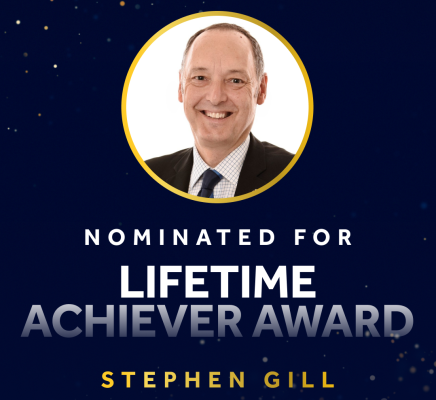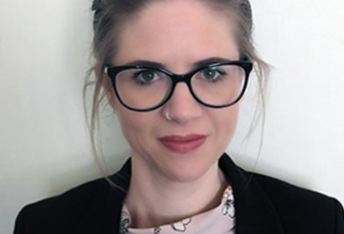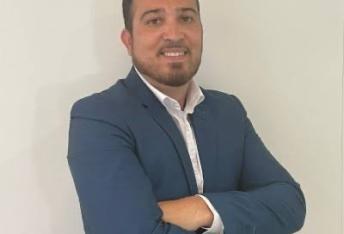Stephen Gill Nominated for the Lifetime Achiever Award, discover his EDI Journey Interview
Stephen Gill Nominated for the Lifetime Achiever Award, discover his EDI Journey Interview

The National Diversity Awards celebrates the excellent achievements in grass root communities. The award Stephen has been nominated for is the ‘Lifetime Achiever’ Award. This award honours the individual who has made significant, innovative and cumulatively outstanding contributions to enhancing the practice of equality and diversity, donating a major portion of their life to their cause. Equality, Diversity and Inclusion (EDI) is about creating a fair and respectful environment where everyone has equal opportunities. It involves treating people fairly (equality), valuing and respecting individual differences (diversity), and making sure everyone feels welcome, supported, and able to contribute (inclusion).
The award ceremony will be held on the 19th September where winners for all categories will be announced.
Journey and Motivation
Q: What does diversity mean to you?
Diversity, to me, means recognising and valuing the full range of human experiences—across background, identity, and perspective. But on its own, diversity is just a number. It becomes meaningful only when inclusion and equity are actively practiced. Inclusion is about building structures and cultures where people don’t just have a seat at the table, but are empowered to contribute and influence outcomes. Crucially, D&I isn’t a tick-box exercise or a separate project—it must be aligned with the organisation or community’s core mission, values, and objectives. That’s where real, sustainable change happens.
Q: Why is diversity important and how can it have positive impacts on communities?
Diversity enriches everything it touches—but only when it’s underpinned by intentional inclusion. When D&I is embedded into the heart of a community’s purpose—not treated as an external or one-off initiative—it has the power to transform. It leads to greater empathy, stronger relationships, and more innovative thinking. It also helps communities adapt to change more effectively. That’s why I always advocate that D&I shouldn’t be seen as an end in itself, but as a driver of excellence, resilience, and justice.
Q: How does it feel to be nominated for the Lifetime Achiever Award?
It’s incredibly humbling and deeply meaningful. I’ve dedicated much of my life to championing inclusion, not as a side issue, but as a central component of excellence—in engineering, in education, in leadership. This nomination may be partly recognition of years of work, but also, it’s a validation of the belief that building fairer systems benefits everyone.
What makes this especially significant to me is that it shows anyone—from any walk of life—can make a difference if they put their mind to it. You don’t need a specific job title, specialist qualification, or official mandate to champion inclusion. I’ve always believed that inclusion is everyone’s business. If something doesn’t feel right or fair, you have the power to speak up, to act, and to create change. That’s what this recognition really highlights—that impact doesn’t require permission. It requires care, commitment, and consistency.
Q: Can you share the moment or experience that first inspired your lifelong commitment to equality and diversity?
The seeds were sown early in life. I grew up in a mining community where I saw bright, capable people held back by systemic barriers. Later, as a neurodivergent professional navigating the engineering world with undiagnosed dyslexia, I experienced first-hand how rigid systems fail to accommodate talent that doesn’t fit a traditional mould. These weren’t isolated moments—they were ongoing patterns. That’s when I realised that inclusion doesn’t happen by default; it requires deliberate effort. And more importantly, it must be tied to the purpose of the organisation or community. You can’t achieve excellence or innovation without inclusion—it’s the foundation, not an optional extra.
Impact
Q: What do you consider to be your most significant contribution to diversity and inclusion?
One of the most significant contributions I believe I’ve made is helping to make diversity and inclusion more relatable, practical, and understandable—especially in technical sectors where it can be perceived as abstract, forced, or even irrelevant. Too often, when people hear the word diversity, their minds go straight to gender or race. Those are vitally important, of course, but diversity is much broader—and deeply intersectional.
Take age, for example. If we talk about the urgent need to attract more young people into our sector, almost everyone agrees. Yet this is diversity in practice—age diversity—but it’s rarely recognised as such because it feels familiar and unthreatening. Similarly, when we advocate for technicians to have professional recognition or for better neurodiversity support, we’re talking about inclusion in a real, grounded way that everyone can connect with. My focus has always been to meet people where they are and show how inclusion benefits everyone—not just a specific group.
In terms of tangible impact, I’ve worked across many strands of diversity—often through an intersectional lens. I’m particularly proud of the Women in Refrigeration, Air Conditioning and Heat Pump (RACHP) Network, which laid the groundwork for the global International Network for Women in Cooling (INWIC). Both initiatives have created supportive spaces not just for women but for all underrepresented voices in the cooling sector—recognising that real inclusion must be open and shared.
I also initiated the Engineering Differently platform, which led to the Engineering Council’s landmark guidance on reasonable adjustments for neurodivergent applicants—the first of its kind. My motivation there was to break down systemic barriers that many didn’t even realise existed, and to provide professional bodies with clear, actionable guidance that aligns inclusion with their core purpose of competence and fairness.
Another significant contribution was leading the creation of the Technician grade of membership at the Institute of Refrigeration (IOR)—a structural change that opened the door to skilled individuals who had been previously excluded simply because their experience didn’t follow the traditional academic path. That was inclusion in action—changing the system to reflect the reality of our workforce.
Q: What challenges have you faced specifically in the refrigeration industry, and how have you tried to overcome these?
The industry can be resistant to change—particularly around inclusion, which is sometimes dismissed as unrelated to technical performance. My response has always been to integrate inclusion with business and operational goals. For example, by showing how diverse, inclusive teams retain staff longer, innovate better, and respond more effectively to client needs. It’s about reframing inclusion not as an external add-on, but as a core enabler of the industry’s success—now and in the future.
Q: How have you seen diversity and inclusion benefit the refrigeration industry?
Where inclusion has been embraced intentionally, the benefits have been clear: more innovative thinking, better talent retention, and stronger community engagement. We’ve also seen shifts in reputation—organisations that lead on D&I are more attractive to young professionals, clients, and collaborators. The key is that inclusion must be purposeful and connected to the organisation’s wider mission. If treated as a tick-box or PR exercise, it won’t stick. But when aligned with core business values, it becomes a genuine competitive advantage.
In the refrigeration sector, which is facing a well-documented and worsening skills shortage, D&I has played a vital role in widening the recruitment pipeline. One of the most visible impacts has come from highlighting role models from traditionally underrepresented groups—women, neurodivergent professionals, and those from different racial, cultural, or social backgrounds. The principle of “you can’t be it if you can’t see it” has proven itself in our industry. By showcasing diverse stories and career journeys, we’ve begun to change perceptions and show that this sector is not only open to everyone—but that it needs everyone.
And we’re already seeing results. More people from underrepresented groups are joining our industry because they now see a place for themselves in it. That’s a major step forward. But visibility and attraction are only the beginning. Now we need to focus on retention. That means building inclusive, supportive environments where people don’t just enter—but stay, grow, and thrive.
That said, I’m increasingly concerned by approaches that attempt to force diversity or measure it purely through isolated metrics. There’s no credible evidence to suggest that this approach delivers lasting success—quite the opposite. While it may result in short-term optics, there are countless anecdotal examples where these efforts have failed to create meaningful change or have even caused backlash and disengagement. Diversity on its own doesn’t guarantee a successful organisation. It’s only when it’s embedded into the culture through systems thinking—where inclusion and equity are aligned with goals, values, and objectives—that it drives long-term, sustainable impact. That alignment is paramount.
Legacy
Q: What are some of the most important lessons you’ve learned within your contributions to diversity and inclusion?
Change doesn’t happen through good intentions alone. Inclusion requires conscious, deliberate action. I’ve also learned that D&I efforts must be systemic—not siloed. That means making sure that inclusion is not a side project or the job of a single person or department, but something embedded in leadership, strategy, and daily operations. When organisations align D&I with their true purpose and values, that’s when transformation occurs.
Q: What advice would you give to younger people starting their journey?
Trust your instincts—and don’t feel obliged to follow anyone’s advice, including mine, without question. I’ve received plenty of poor advice over the years, often from senior people who I assumed knew better simply because of their experience. Yes, they had years in the role—but time served doesn’t always equal doing things right. Some well-intentioned individuals built long and successful careers while unknowingly perpetuating exclusion, convinced they were being welcoming and inclusive. Sometimes they were simply repeating what had always been done, without questioning whether it still served everyone—or ever did.
So yes, listen and learn—but always think critically. Ask yourself: What does inclusion look like in my environment—and where is it missing? Be prepared to ask uncomfortable questions and to sit with uncomfortable truths. Don’t wait for the ideal moment to start making a difference; meaningful change often begins in small, informal ways. But always tie your efforts to something bigger: what’s the purpose, what values are you upholding, what are you trying to improve?
When your inclusion efforts are connected to the broader mission and values of your organisation or community, they become much more than well-meaning gestures—they become transformative. That’s where real impact starts.
Q: As societies and industries continue to evolve, what do you see as the most urgent issues in equality and diversity today?
The biggest risk right now is complacency. There’s a temptation to treat diversity as a trend that’s now run its course—especially when the numbers look better then they did. But diversity without inclusion is meaningless. Worse, it can lead to frustration and disengagement. We must move beyond representation to transformation. That means aligning D&I with the systems we’re trying to improve—workplace cultures, hiring practices, leadership models—so that inclusion becomes how we operate, not just what we aspire to.
Q: How do you hope your work will continue to influence future generations?
I hope it shows that inclusion is not a cost, but an investment—and that it’s not a distraction from excellence, but its foundation. If future generations can embed inclusive thinking into the DNA of their organisations and communities—not as a separate goal, but as a means of achieving their core purpose—then the work will have lasting value.
I want them to inherit systems where barriers are noticed early, challenged openly by everyone—not just inclusion specialists—and removed collaboratively. That’s the kind of culture that drives innovation, wellbeing, and sustainability.
Specifically, within the RACHP sector, I hope to leave behind an industry that is stronger, more resilient, and truly welcoming to all those who make it special. One that doesn’t just attract talent from diverse backgrounds but retains it—by offering fulfilling, thriving careers where individuals can contribute to the best of their ability. When that happens, the collective impact is profound: not only do we build better teams and businesses, but we improve the lives of many through the essential services our industry provides. That’s the legacy I hope to leave.


